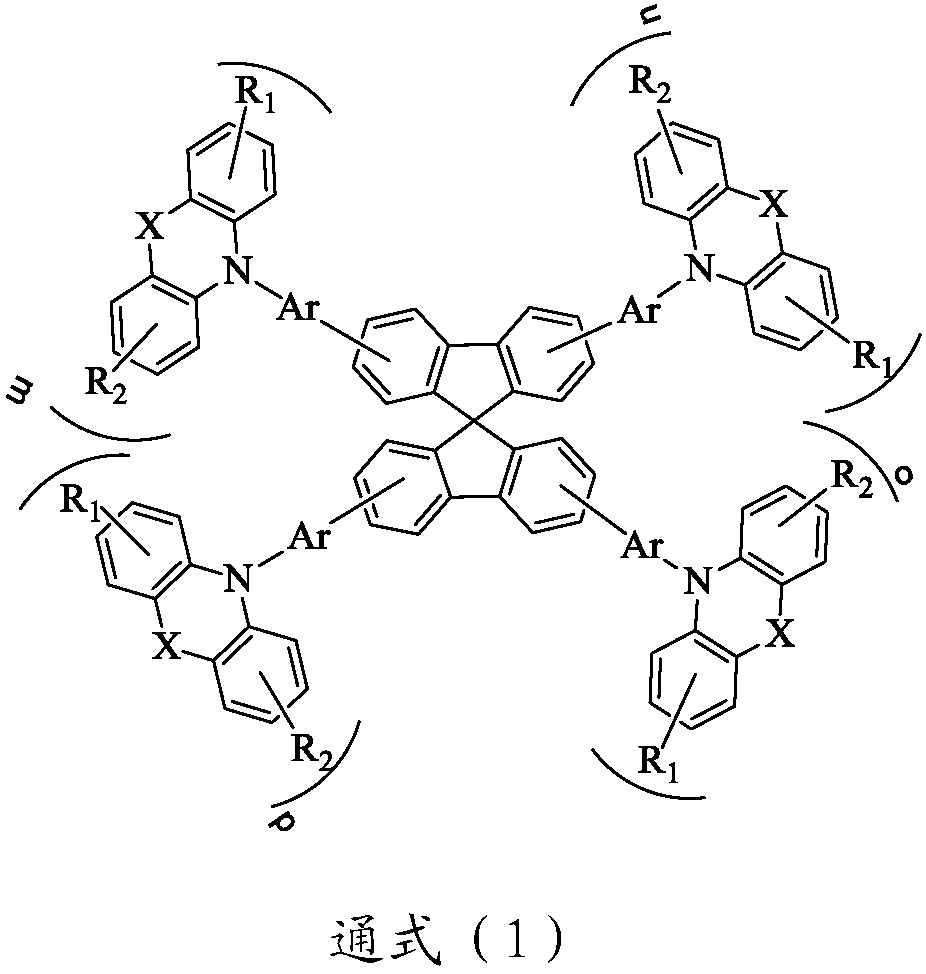Organic compound containing 9,9'-spirobifluorene as core and OLED (organic light emitting diode) device
A technology of electroluminescent devices and organic compounds, applied in the fields of organic chemistry, electro-solid devices, electrical components, etc., can solve different problems, improve current efficiency and life, improve exciton utilization and high fluorescence radiation efficiency, The effect of good industrialization prospects
- Summary
- Abstract
- Description
- Claims
- Application Information
AI Technical Summary
Problems solved by technology
Method used
Image
Examples
Embodiment 1
[0137] Embodiment 1: the synthesis of compound 5:
[0138] synthetic route:
[0139]
[0140] In a 250ml three-necked flask, under the protection of nitrogen, add 0.01mol 3-bromo-9,9'-spirobifluorene, 0.012mol intermediate A1, 150ml toluene and stir to mix, then add 0.02mol sodium carbonate, 1×10 -4 mol Pd(PPh 3 ) 4 , heated to 105 ° C, reflux reaction for 24 hours, sampling point plate, showing no bromide remaining, the reaction is complete; naturally cooled to room temperature, filtered, the filtrate was subjected to vacuum rotary evaporation (-0.09MPa, 85 ° C), passed through neutral silica gel Column, obtain target product, HPLC purity 99.1%, yield 72.4%;
[0141] Elemental analysis structure (molecular formula C 52 h 35 NO): Theoretical C, 90.54; H, 5.11; N, 2.03; O, 2.32; Tested: C, 90.53; H, 5.12; N, 2.04;
[0142] HPLC-MS: The molecular weight of the material is 689.27, and the measured molecular weight is 689.53.
Embodiment 2
[0143] Embodiment 2: the synthesis of compound 6:
[0144] synthetic route:
[0145]
[0146] In a 250ml three-neck flask, under nitrogen protection, add 0.01mol 3-bromo-9,9'-spirobifluorene, 0.012mol intermediate B1, 150ml toluene and stir to mix, then add 0.02mol sodium carbonate, 1×10 -4 mol Pd(PPh 3 ) 4 , heated to 105 ° C, reflux reaction for 24 hours, sampling point plate, showing no bromide remaining, the reaction is complete; naturally cooled to room temperature, filtered, the filtrate was subjected to vacuum rotary evaporation (-0.09MPa, 85 ° C), passed through neutral silica gel Column, obtain target product, HPLC purity 99.2%, yield 71.8%;
[0147] Elemental analysis structure (molecular formula C 52 h 35 NO): Theoretical C, 90.54; H, 5.11; N, 2.03; O, 2.32; Tested: C, 90.55; H, 5.10; N, 2.02;
[0148] HPLC-MS: The molecular weight of the material is 689.27, and the measured molecular weight is 689.57.
Embodiment 3
[0149] Embodiment 3: the synthesis of compound 10:
[0150] synthetic route:
[0151]
[0152] In a 250ml three-necked flask, under the protection of nitrogen, add 0.01mol 3-bromo-9,9'-spirobifluorene, 0.012mol intermediate C1, 150ml toluene and stir to mix, then add 0.02mol sodium carbonate, 1×10 -4 mol Pd(PPh 3 ) 4 , heated to 105 ° C, reflux reaction for 24 hours, sampling point plate, showing no bromide remaining, the reaction is complete; naturally cooled to room temperature, filtered, the filtrate was subjected to vacuum rotary evaporation (-0.09MPa, 85 ° C), passed through neutral silica gel Column, obtain target product, HPLC purity 99.1%, yield 71.5%;
[0153] Elemental analysis structure (molecular formula C 52 h 35 NO): Theoretical C, 90.54; H, 5.11; N, 2.03; O, 2.32; Tested: C, 90.53; H, 5.13; N, 2.01;
[0154] HPLC-MS: The molecular weight of the material is 689.27, and the measured molecular weight is 689.55.
PUM
| Property | Measurement | Unit |
|---|---|---|
| thickness | aaaaa | aaaaa |
| thickness | aaaaa | aaaaa |
| thickness | aaaaa | aaaaa |
Abstract
Description
Claims
Application Information
 Login to View More
Login to View More - R&D
- Intellectual Property
- Life Sciences
- Materials
- Tech Scout
- Unparalleled Data Quality
- Higher Quality Content
- 60% Fewer Hallucinations
Browse by: Latest US Patents, China's latest patents, Technical Efficacy Thesaurus, Application Domain, Technology Topic, Popular Technical Reports.
© 2025 PatSnap. All rights reserved.Legal|Privacy policy|Modern Slavery Act Transparency Statement|Sitemap|About US| Contact US: help@patsnap.com



